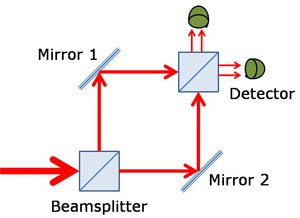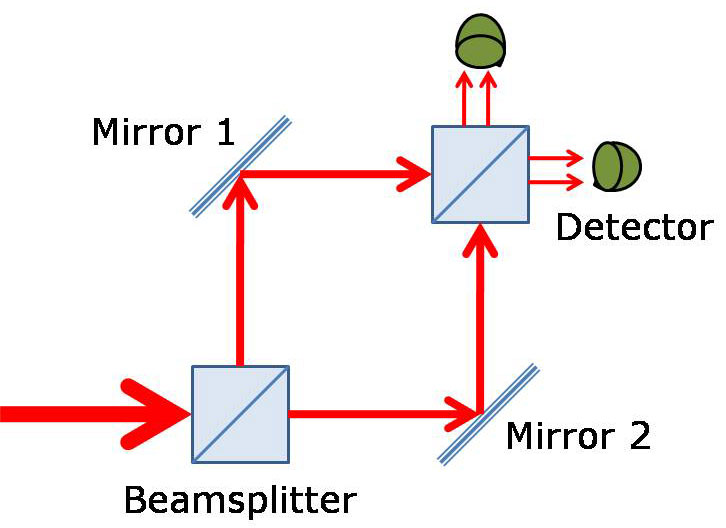Another Step Back for Wave-Particle Duality
Quantum physics tells us that a photon isn’t strictly a particle or strictly a wave. And yet most of us will revert back—whenever we can—to familiar concepts of billiard balls or vibrating strings when picturing photons in our heads. A new thought experiment, proposed in Physical Review Letters, hopes to break us of these old habits. The authors imagine a type of quantum switch that controls whether a simple optical measurement tests for particlelike or wavelike behavior in a single photon. This slight reworking of a famous experiment demonstrates with logical precision the futility of trying to label the photon as a particle or a wave.
The wave-particle duality is often illustrated by splitting a light beam so that it travels along two separate paths that later merge to form an interference pattern from the combined beams. For a dim beam delivering photons one-at-a-time, this interference suggests that each photon is a wave that travels down both paths simultaneously. But if the paths are observed individually, then the photon will behave like a particle, traveling down only one path or the other and generating no interference. The fact that no experiment can measure both the wave and the particle behaviors simultaneously is called the principle of complementarity.
Someone unhappy with this indeterminacy could imagine that the photon somehow knows what measuring devices lie ahead and thereby decides in advance to go down both paths or one path, accordingly. To deny us this conceit, John Wheeler, at the University of Texas, proposed a thought experiment 30 years ago in which a “wave detector” suddenly switches to a “particle detector” during the photon’s travels, or vice versa.
This so-called delayed-choice experiment was performed in 2007 using an interferometer [1]. In the normal setup, a beam splitter creates two separate light beams that later recombine in a second beam splitter. Detectors placed at the two outputs of this beam splitter both register an interference pattern. However, this wave detector can be turned into a particle detector by removing the second beam splitter, so that the two paths no longer interfere. In the experiment, the choice to add or remove the second beam splitter was made after an individual photon had already passed through the first beam splitter. The data showed that particle and wave behavior were unaffected by the delayed choice, as expected from standard quantum mechanics.
Radu Ionicioiu, now at the Institute for Quantum Computing in Waterloo, Canada, and Daniel Terno of Macquarie University in Sydney, Australia, wanted to see what happens in the thought experiment if the delayed choice is made through quantum means. They imagined that the interferometer contains a quantum device—perhaps an atom in a cavity or a micro-mirror placed on a cantilever—that can exist in two possible states. One state selects the particle experiment, and the other selects the wave experiment. This quantum control element can be placed in a combination, or superposition, of its two states, making the whole experiment participate in the wave-particle duality.
“We show you can do both wave and particle experiments at once,” Ionicioiu says. This means the choice of wave vs particle can be delayed indefinitely. The photon can be observed at one of the detectors and still not “know” if it is supposed to be a wave or a particle. It’s only when the observer decides to measure the state of the quantum control that the photon’s behavior can be identified as wavelike or particlelike.
The idea of having measurements depend on some secondary quantum effect was explored previously in the so-called quantum eraser [2]. But this new, simpler thought experiment allows a direct analysis of the information flows between experimental elements, Ionicioiu says. Within this simplified framework, the theorists evaluated certain alternative theories to standard quantum mechanics known as “hidden variable” theories and showed that they would have to be absurdly complicated to reproduce the results of their quantum delayed-choice experiment.
This proof doesn’t come as a surprise. “We know very well that quantum phenomena cannot be described by hidden-variable theories, unless they have utterly implausible and unacceptable properties,” says Berthold-Georg Englert of the National University of Singapore. Marco Genovese of the Italian Metrological Institute (INRIM) in Turin agrees that the basic concepts here are not new. But he still very much likes this simple thought experiment for the way it points out the paradoxes that emerge from treating the photon as a classical particle or wave.
–Michael Schirber
Michael Schirber is a Corresponding Editor for Physics Magazine based in Lyon, France.
References
- V. Jacques, E Wu, F. Grosshans, F. Treussart, P. Grangier, A. Aspect, and J.-F. Roch, “Experimental Realization of Wheeler’s Delayed-Choice Gedanken Experiment,” Science 315, 966 (2007)
- Y-H. Kim, R. Yu, S. P. Kulik, Y. Shih, and M. O. Scully, “Delayed ‘Choice’ Quantum Eraser,” Phys. Rev. Lett. 84, 1 (2000)





